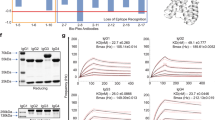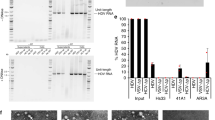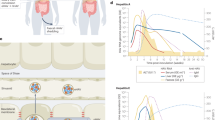Abstract
Infection with hepatitis B virus is associated with the appearance in the serum of a specific antigen, hepatitis B surface antigen (HBsAg), a serologically complex structure present on the coat of the double-shelled 42-nm hepatitis B virus (HBV) particle. HBsAg is also present, often in large excess, in the form of small, spherical 20–25-nm particles in the sera of infected individuals1. The serologically distinct core (HBcAg) or nucleocapsid of the 42-nm virus is 27 nm in diameter and contains double-stranded circular DNA with a molecular weight (MW) of 1.6–2.0 × 106, and an associated DNA polymerase2. A third antigen, hepatitis B e antigen (HBeAg), appears to correlate with the number of virus particles3 and the relative degree of infectivity of surface antigen-positive sera4, is frequently detected free in the serum and has been shown to be closely associated with the viral core5. Failure to propagate hepatitis B virus serially in tissue culture is a major obstacle to precise biochemical characterisation of the antigens and the development of vaccines against this important infection. The use of purified HBsAg 20–25-nm particles prepared from the sera of persistently infected donors for the immunoprophylaxis of hepatitis B is being investigated6. Such preparations have been shown to protect susceptible chimpanzees on challenge with HBV7,8. There are, however, problems associated with the collection of HBsAg positive sera from persistently infected carriers. The recent establishment of a HBsAg-producing cell line from a human hepatoma9,10 has provided an alternative source of HBsAg particles with the added advantage that both the production and quality of the antigen may be more precisely controlled. The availability of this cell line also facilitates the study of HBV gene products by biochemical methods applicable to cultured cells, in the absence of contaminating serum proteins. In this study, the 20–25-nm HBsAg particles produced by these cells were characterised and compared with those derived from the sera of persistently infected human carriers.
This is a preview of subscription content, access via your institution
Access options
Subscribe to this journal
Receive 51 print issues and online access
$199.00 per year
only $3.90 per issue
Buy this article
- Purchase on Springer Link
- Instant access to full article PDF
Prices may be subject to local taxes which are calculated during checkout
Similar content being viewed by others
References
Howard, C. R. & Burrell, C. J. Prog. med. Virol. 22, 36–103 (1976).
Robinson, W. S. A. Rev. Microbiol. 31, 357–377 (1978).
Howard, C. R., Zanetti, A. R., Thal, S. & Zuckerman, A. J. J. clin. Path. 31, 681–687 (1978).
Alter, H. J. et al. New Engl. J. Med. 295, 909–913 (1976).
Takahashi, K. et al. J. Immun. 122, 275–279 (1979).
Szmuness, W. J. med. Virol. (in the press).
Purcell, R. H. & Gerin, J. L. in Viral Hepatitis (eds Vyas, G. N., Cohen, S. N. & Schmid, R.) 491–505 (Franklin Institute Press, Philadelphia, 1978).
Buynak, E. B. et al. Proc. Soc. exp. Biol. Med. 151, 694–700 (1976).
Alexander, J. J., Bey, E. M., Geddes, E. W. & Lecatsas, G. S. Afr. med. J. 50, 2124–2128 (1976).
Macnab, G. M., Alexander, J. J., Lecatsas, G., Bey, E. M. & Urbanowicz, J. M. Br. J. Cancer 34, 509–515 (1976).
Zuckerman, A. J. & Howard, C. R. in Comparative Diagnosis of Viral Diseases Vol II (ed. Kurstak, E.) 35–85 (Academic, New York, 1977).
Skelly, J., Howard, C. R. & Zuckerman, A. J. J. gen. Virol. 41, 447–457 (1978).
Alexander, J., Macnab, G. & Saunders, R. in Perspectives in Virology Vol. 10 (ed. Pollard, M.) 103–120 (Raven, New York, 1978).
Bolton, A. E. & Hunter, W. M., Biochem, J. 133, 529–539 (1973).
Skelly, J., Howard, C. R. & Zuckerman, A. J. J gen. Virol. 44, 679–689 (1979).
Peterson, D. L., Roberts, I. M. & Vyas, G. H. Proc. natn. Acad. Sci. U.S.A. 74, 1530–1534 (1977).
Shih, J. W. K. & Gerin, J. L. J. Virol. 21, 347–357 (1977).
Cabral, G. A. et al. J. gen. Virol. 38, 339–350 (1978).
Howard, C. R. J. med. Virol. 3, 81–86 (1978).
Author information
Authors and Affiliations
Rights and permissions
About this article
Cite this article
Skelly, J., Copeland, J., Howard, C. et al. Hepatitis B surface antigen produced by a human hepatoma cell line. Nature 282, 617–618 (1979). https://doi.org/10.1038/282617a0
Received:
Accepted:
Issue Date:
DOI: https://doi.org/10.1038/282617a0
This article is cited by
-
Experimental models of hepatocellular carcinoma: developments and evolution
Journal of Cancer Research and Clinical Oncology (2009)
-
Comparative effects of α, β and γ human interferons on a HBsAg-producing human hepatoma cell line
La Ricerca in Clinica e in Laboratorio (1986)
-
Hepatitis B virus components produced by the human hepatoma cell line PLC/PRF/5: Do they indicate virus propagation?
Archives of Virology (1986)
-
Characterization of growth parameters of a human hepatoma cell line cultured under serum-free conditions
La Ricerca in Clinica e in Laboratorio (1985)
-
Establishment and characterization of a new human hepatocellular carcinoma cell line
In Vitro (1984)
Comments
By submitting a comment you agree to abide by our Terms and Community Guidelines. If you find something abusive or that does not comply with our terms or guidelines please flag it as inappropriate.



